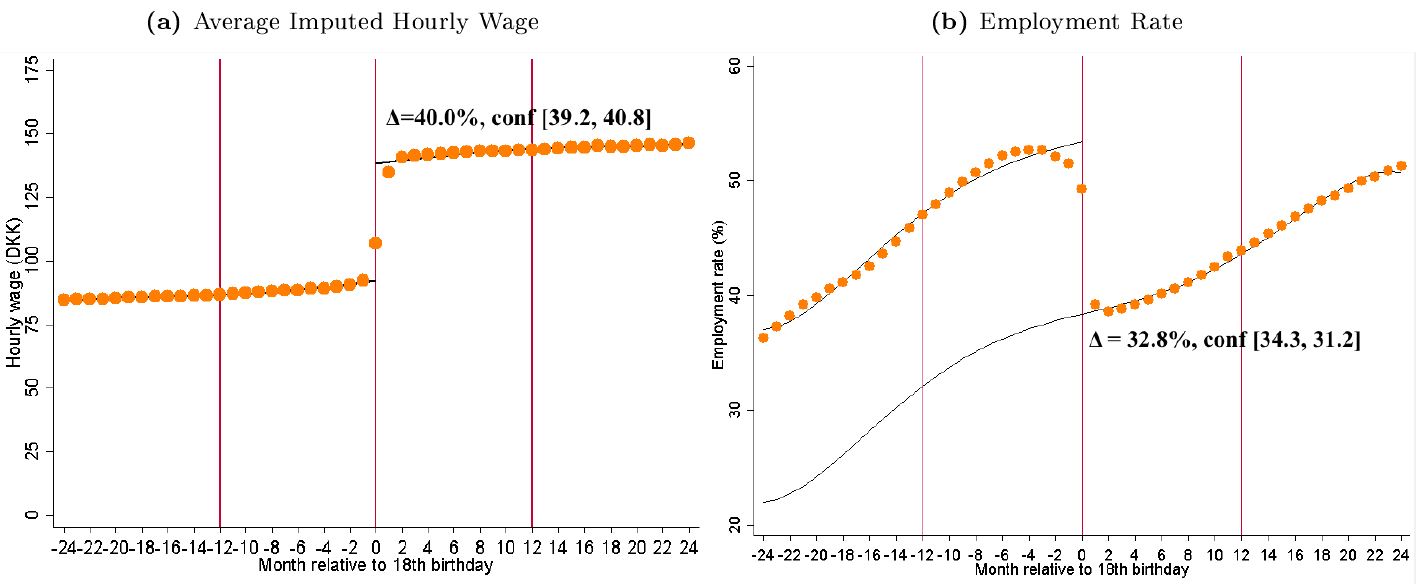The recent University of Washington working paper on the Seattle minimum wage, and its finding that low wage workers have seen average pay go down in response to the increases so far, has generated a substantial amount of coverage. The paper adds important insights into the ways a minimum wage increase affects low-wage workers, and is particularly timely as states and cities embark on a series of minimum wage hikes.
Young people are particularly affected by the minimum wage because they have less work experience and limited skills. For many of them, finding employment is about getting a first job and developing tools they need for better opportunities in the future. In recognition of the outsized harm the minimum wage might have on young workers, many European countries, including Denmark, have a lower youth minimum wage. This structure leads to a discontinuity in the minimum wage, as it jumps significantly when a person reaches age 18.
In a recent study, Claus Thustrup Kreiner of the University of Copenhagen, Daniel Reck of the University of California Berkeley, and Peer Ebbeson Skov of Auckland University of Technology used administrative data with quarterly information on wages, hours worked, and employment, which allowed them to examine the effect of this minimum wage discontinuity on a range of metrics.
Their main findings are that the approximately 40 percent increase in the average hourly wage rate at age 18 led to a 15 percentage-point decrease in employment, which corresponds to a 33 percent decrease in the number of people employed. Total labor input, which also incorporated changes in hours worked, declined by approximately 45 percent.
Wages and Employment around Workers' 18th Birthdays
Source: Kreiner, Reck and Skov, “Do Lower Minimum Wages for Young Workers Raise their Employment? Evidence from a Danish Discontinuity,” June 2017.
In its 2014 report the Congressional Budget Office estimates a 10 percent increase would reduce youth employment by three-quarters of one percent. As the authors of the Danish study point out, this estimate is not based on changes to a youth minimum wage, but a general minimum wage increase. In this analysis focusing specifically on changes to a minimum wage affecting the young, the authors estimate that a 10 percent increase would cause youth employment to fall by 8 percent, while total hours would fall by 11 percent. The corresponding reductions in employment rate and hours worked lead to their finding of “nearly no effect on average earnings” even with the substantial increase to the average wage earned.
What are the consequences of the job losses at 18 caused by the minimum wage? The differences in employment rates for workers who did lose their jobs when they turned 18 to those that did not is substantial and persistent. One year after losing a job at age 18, only 40 percent of those young people are working, compared to 75 percent who were able to keep a job. This dynamic is not likely to be driven by underlying worker characteristics because this gap is much smaller in the months before age 18. The adverse effects on young people could last for a long-time and alter the entire trajectories of their working lives, as they lose valuable time to accumulate human capital and work experience.
There are some aspects of the study that limit the importance of the findings for the ongoing debate about minimum wage in America. Unlike the United States, in Denmark the minimum wage is determined by a series of collective wage agreements between unions and employer organizations, but these agreements cover 80 to 90 percent of Danish workers and there is a sharp increase in the wage rate at age 18 across all industries.
The minimum wage level in the study is also higher than it is in the United States, and recent research such as the latest Seattle study suggest that the disemployment effect of minimum wage increases are nonlinear, larger increases elicit significantly large responses. However, the level in the study is in the vicinity of the endpoints of some of the increases passed at the state and local level, and similar to the $15 national wage advocated by some minimum wage proponents.
These findings imply that moving from a regime where everyone is subject to the same minimum wage to one where there is a lower youth minimum wage could substantially increase youth employment and hours worked because labor input for young workers is very responsive to changes in a youth-specific minimum wage. Getting more young people into the workforce would allow them to accumulate human capital and lead to more of them transitioning to higher-paying, better jobs later in life. Although nominally a federal youth minimum wage exists in the United States, in most states it is not applicable. Previous research by Preston Cooper for the Manhattan Institute estimated that if the federal government adopted a lower youth minimum wage, the economy would generate as many as 450,000 additional jobs for teenagers aged 16–19 in the first year.
While many places are considering substantial minimum wage increases, careful consideration should be given to the potential adverse consequences. At the same time, more widespread adoption of a youth minimum wage could lead to many more opportunities for them.
Charles Hughes is a policy analyst at the Manhattan Institute. Follow him on twitter @CharlesHHughes.
Interested in real economic insights? Want to stay ahead of the competition? Each weekday morning, E21 delivers a short email that includes E21 exclusive commentaries and the latest market news and updates from Washington. Sign up for the E21 Morning Ebrief.

